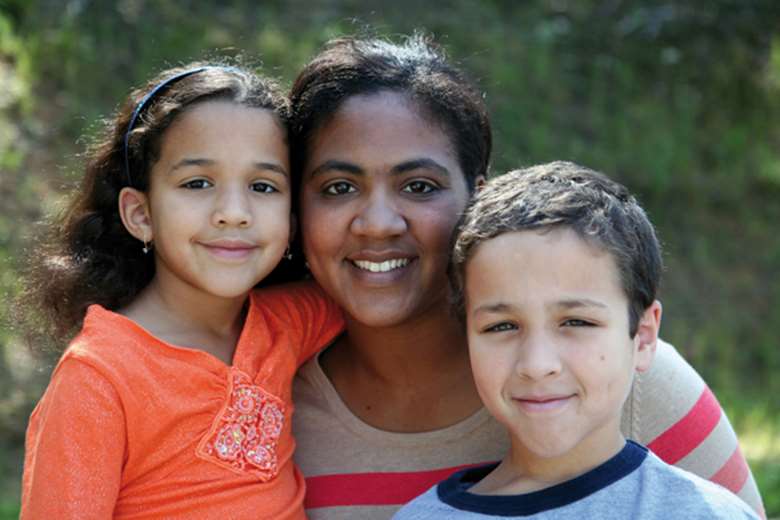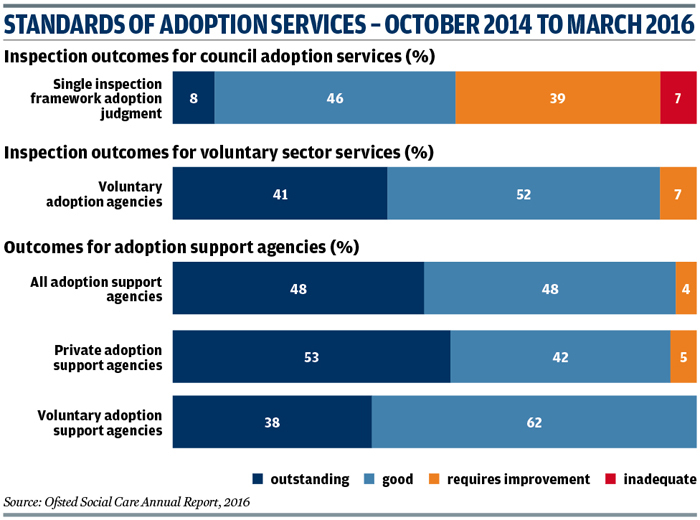Behind the Inspection Ratings: Adoption services
Jo Stephenson
Tuesday, October 25, 2016
The standard of adoption services across local authorities and the voluntary sector has steadily improved in recent years, bucking the overall trend in Ofsted inspections, social care report shows.

Adoption is supported by a complex mix of services but standards are generally high, data from Ofsted shows. This is true of local authority adoption services responsible for every aspect of adoption and inspected on performance as part of Ofsted's single inspection framework for children's services.
"The majority of local authorities deliver either good or outstanding adoption services, and this reflects a pattern that has been established for many years," says Ofsted's 2016 annual report on social care.
This is the case even for councils struggling with other aspects of children's services. Many rated "requires improvement" overall, such as Brighton & Hove, are still achieving a "good" rating for adoption (see case study).
At the end of March 2016, eight per cent of councils were rated "outstanding" for adoption, while 46 per cent were rated "good". Meanwhile, 39 per cent were judged "requires improvement" and seven per cent "inadequate" (see graphic).
Figures from the Department for Education show the vast majority of looked-after children placed for adoption - 91 per cent - living with local authority adopters, with nine per cent living with voluntary adoption agency adopters.
Ofsted data shows standards are particularly high among voluntary adoption services.
At the end of March 2016, 93 per cent of voluntary adoption agencies, which provide some of the same services as councils like recruiting adopters, placing children and aftercare, were rated good or outstanding.
For voluntary support agencies, which provide support before, during and after adoption but do not place children or match adopters, 96 per cent were in the top two ratings, compared to 91 per cent for private agencies.
Factors behind the positive picture across adoption services include the relatively consistent level of demand, explains Hugh Thornbery, chief executive of adoption support charity Adoption UK.
"Although we have had a recent peak in terms of the number of children adopted, followed by a fall, that peak was preceded by a government investing in local authority and adoption agency capacity, so there has been a degree of protection for adoption services," he says.
Another factor is that the sector is characterised by a relatively stable and highly experienced workforce.
"I am struck in working with adoption agencies across the country just how long the majority of staff have been involved in adoption and also the degree of stability in terms of continuous employment with the same local authority or voluntary agency," says Thornbery.
The downside of that is a degree of conservatism and lack of innovation - but the government's adoption reform agenda has shaken things up, including reducing the average amount of time from a child entering care to being adopted. This fell between 2012 and 2015 from two years and seven months to two years and three months.
There is ongoing scrutiny and a new inspection framework introduced by Ofsted last year may well lead to fewer services achieving top ratings."Where adoption support is effective, children and families do not experience delays in accessing or receiving help," says Ofsted's report.
"For adopters, support equips them with theory and supportive strategies to respond effectively to the child."
One area where voluntary agencies have tended to outshine local authority services is in the area of post-order support. Whereas voluntary organisations generally have more flexibility - including when it comes to accessing sources of funding over and above fees - councils are more constrained hence the introduction of the Adoption Support Fund.
This has proved successful, but revealed high levels of unmet need among families experiencing real difficulties. The government announced the introduction of caps to funding for those seeking therapeutic support (see Analysis, p14).
In 2016, there was a sharp drop in the number of adoptions - the first fall since 2011. This followed a decrease in the number of children being placed for adoption partly as a result of greater emphasis on alternative arrangements including kinship care.
There is now a surplus of adopters and councils have scaled back recruitment campaigns, with some closing their doors to new enquiries.
The surplus should be good for children because it will mean a wider choice of prospective adoptive parents, although it does not guarantee swift matching especially for the 2,000 or so "harder-to-place" children who have been awaiting adoption for a long time.
However, the drop in numbers has had a "catastrophic effect" on the voluntary adoption sector by vastly reducing services' income from finding adopters for councils, says Thornbery.
"When volumes fall, your income falls and most voluntary agencies will have cut their workforce by 25 per cent at least," he says.
But he doubts this will affect the quality of provision as services will readjust to fit demand.
Moves to develop regional adoption agencies may mean some short-term disruption with the "risk of going backwards before we go forwards", but the main challenge remains the overall climate of austerity, maintains Thornbery.
"The biggest challenge - and my greatest concern - is around whether we can continue to further improve the system and make significant changes, including to mental health services for children, to ensure needs are met," he says.

Brighton raises profile of adoption support
- Brighton & Hove Council
- Requires improvement overall - good for adoption
- June 2015
Brighton & Hove has strived to improve adoption services and support including commissioning a wide-ranging piece of independent research to look at provision and identify gaps, explains Karen Devine, service manager for adoption and permanence, family and friends.
This exercise, funded using Adoption Support Fund money and carried out in 2012/13, led to the establishment of a strategic steering group to drive progress and has proved to be "effective" when it came to raising awareness of the needs of adopted children and their new families, she says.
Made up of senior leaders from a range of agencies, including health, education, youth services and early years, plus voluntary agencies and adoptive parents, the group has sought to promote all-round responsibility for adoption support rather than it simply being seen as the concern of the local authority adoption service.
The initiative has involved the creation of the Adoption Support Passport, an online resource that provides clear information and advice on support available to adoptive families. It has also seen all partners explore how to make their provision more "adoption-friendly" with each identifying an "adoption champion".
For example, the authority's virtual school has led efforts to promote "attachment-aware" practice in teaching and education with training on offer to schools. Meanwhile, adopters have been actively encouraged to identify themselves to schools to enable settings to make use of Pupil Premium funding.
In 2014, 228 schoolchildren were identified as eligible for Pupil Premium funding due to being adopted or having special guardianship arrangements, but this increased to 326 pupils the following year meaning a £186,000 increase in funding to £619,400 by January 2015.
In total, 45 children were approved for adoption in Brighton & Hove in 2015/16, and 30 children were placed for adoption including three sibling pairs.
The authority's success in ensuring good matches is evidenced by a zero adoption disruption rate in recent years.
Key factors include a high standard of assessment for adopters and prospective adopters with support that ensures they are ready for the challenges of adoption, says Devine.
"Our adoption team supports children's social workers in arriving at a timely adoption plan and in thinking about the support we need to give that child for them to be ready to access an adoptive family," she adds.
The process includes staging a "child appreciation day" where all the key professionals involved in a child's life such as social workers, health visitors, teachers and foster carers share information with the adopters to help them understand the child's experiences and needs.
When it comes to post-adoption support, this is factored in at the earliest opportunity, with adoptive parents getting post-approval support and training.
Rather than waiting for adopters to come to the local authority with any problems, a carefully thought-out package of ongoing support is put in place from the start.
"What we and a lot of agencies did in the past was to give families time and wait for them to come back," says Devine. "But we're more pro-active these days in terms of thinking ‘this is what you're going to need and we want to set this up now' rather than waiting for you to start experiencing challenges and difficulties later on."




